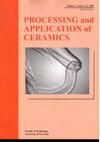Structure and dielectric properties of Lu-doped SrBi2Ta2O9 synthesized by the molten salt method
IF 0.8
4区 材料科学
Q3 MATERIALS SCIENCE, CERAMICS
引用次数: 0
Abstract
Lu-doped SrBi2Ta2O9 (SrBi2-xLuxTa2O9 where x = 0, 0.025, 0.05, 0.75 and 0.1) powders were synthesized by combination of molten salt method and solid-state route. FTIR, Raman and XRD techniques were performed to follow the transformation of reactants into the desired products. Characterization of all samples shows pure and single-phase orthorhombic structured materials obtained with plate-like morphology that is composed of fine and coarse-grained particles. The prepared powders were pressed and sintered at different temperatures up to 1200?C. Microstructure of the sintered samples is also likely to be affected by doping. The first study of dielectric measurements describes the effect of the application of DC bias, at roomtemperature, on the undoped and Lu-doped ceramics and shows that there is little or no effect of DC bias. The sample SrBi1.95Lu0.05Ta2O9 had maximal dielectric constant (??) and minimal dielectric loss (tan?). In the second part of this work, the temperature dependence of ?? and tan_ was considered. It was concluded that Lu-doping not only reduces the Curie temperature, but also brings a diffused phase transition, showing a crossover between displacive and diffusive behaviour.熔盐法制备掺镧SrBi2Ta2O9的结构和介电性能
采用熔盐法和固态法相结合的方法合成了掺镧SrBi2Ta2O9 (SrBi2-xLuxTa2O9, x = 0、0.025、0.05、0.75和0.1)粉末。利用红外光谱(FTIR)、拉曼光谱(Raman)和x射线衍射(XRD)技术跟踪了反应物转化为所需产物的过程。所有样品的表征显示获得的纯单相正交结构材料具有板状形貌,由细颗粒和粗颗粒组成。制备的粉末在不同温度下进行压制和烧结,温度最高可达1200℃。烧结样品的微观结构也可能受到掺杂的影响。第一个介电测量研究描述了直流偏置在室温下对未掺杂和掺镧陶瓷的影响,并表明直流偏置的影响很小或没有影响。样品SrBi1.95Lu0.05Ta2O9具有最大介电常数(??)和最小介电损耗(??)。在本工作的第二部分,研究了??tan_被考虑过。结果表明,镧的掺杂不仅降低了居里温度,而且导致了扩散相变,表现出位移和扩散行为的交叉。
本文章由计算机程序翻译,如有差异,请以英文原文为准。
求助全文
约1分钟内获得全文
求助全文
来源期刊

Processing and Application of Ceramics
MATERIALS SCIENCE, CERAMICS-
CiteScore
1.90
自引率
9.10%
发文量
14
审稿时长
10 weeks
期刊介绍:
Information not localized
 求助内容:
求助内容: 应助结果提醒方式:
应助结果提醒方式:


